Spatiotemporal Heterogeneity and the Key Influencing Factors of PM2.5 and PM10 in Heilongjiang, China from 2014 to 2018
Abstract
1. Introduction
2. Materials and Methods
2.1. Study Area
2.2. Data
2.2.1. Air Pollutants Data
2.2.2. Meteorological Data
2.2.3. MODIS NDVI
2.3. Methods
2.3.1. Principal Component Analysis
2.3.2. Global Model (PCA-OLS)
2.3.3. Local Models
PCA-GWR Model
PCA-GTWR and PCA-TWR Model
2.3.4. Model Assessment
3. Results
3.1. Principal Component Analysis
3.2. Globel Model (PCA-OLS)
3.3. Local Models
3.4. Model Assessment
3.5. Spatial Characteristics of PCA-GTWR Parameter Estimates for PM
3.6. Temporal Characteristics of PCA-GTWR Parameter Estimates for PM
4. Discussion
4.1. The Key Influencing Factors of PM
4.2. Global and Local Models
4.3. The Spatial and Temporal Distribution of PM Concentrations in Heilongjiang Province
5. Conclusions
Author Contributions
Funding
Institutional Review Board Statement
Informed Consent Statement
Data Availability Statement
Conflicts of Interest
References
- Yin, H.; Brauer, M.; Zhang, J.; Cai, W.; Navrud, S.; Burnett, R.; Howard, C.; Deng, Z.; Kammen, D.M.; Schellnhuber, H.J.; et al. Population ageing and deaths attributable to ambient PM2.5 pollution: A global analysis of economic cost. Lancet Planet. Health 2021, 5, e356–e367. [Google Scholar] [CrossRef]
- Wang, H.; Zhang, L.; Cheng, I.; Yao, X.; Dabek-Zlotorzynska, E. Spatiotemporal trends of PM2.5 and its major chemical components at urban sites in Canada. J. Environ. Sci. 2020, 103, 1–11. [Google Scholar] [CrossRef] [PubMed]
- Choi, H.G.; Lee, C.H.; Yoo, D.M.; Min, C.; Park, B.; Kim, S.Y. Effects of short- and long-term exposure to air pollution and meteorological factors on Meniere’s disease. Sci. Rep. 2021, 11, 16063. [Google Scholar] [CrossRef] [PubMed]
- Wei, Q.; Zhang, L.; Duan, W.; Zhen, Z. Global and Geographically and Temporally Weighted Regression Models for Modeling PM2.5 in Heilongjiang, China from 2015 to 2018. Int. J. Environ. Res. Public Health 2019, 16, 5107. [Google Scholar] [CrossRef] [PubMed]
- Dominici, F.; Peng, R.D.; Bell, M.L.; Pham, L.; McDermott, A.; Zeger, S.L.; Samet, J.M. Fine Particulate Air Pollution and Hospital Admission for Cardiovascular and Respiratory Diseases. JAMA 2006, 295, 1127–1134. [Google Scholar] [CrossRef]
- Xing, Y.F.; Xu, Y.H.; Shi, M.H.; Lian, Y.X. The impact of PM2.5 on the human respiratory system. J. Thorac. Dis. 2016, 8, E69–E74. [Google Scholar]
- Apte, J.S.; Marshall, J.D.; Cohen, A.J.; Brauer, M. Addressing global mortality from ambient PM2.5. Environ. Sci. Technol. 2015, 49, 8057–8066. [Google Scholar] [CrossRef]
- Gu, K.; Zhou, Y.; Sun, H.; Dong, F.; Zhao, L. Spatial distribution and determinants of PM2.5 in China’s cities: Fresh evidence from IDW and GWR. Environ. Monit. Assess. 2020, 193, 15. [Google Scholar] [CrossRef]
- Wang, Y.; Yao, L.; Wang, L.; Liu, Z.; Ji, D.; Tang, G.; Zhang, J.; Sun, Y.; Hu, B.; Xin, J. Mechanism for the formation of the January 2013 heavy haze pollution episode over central and eastern China. Sci. China Earth Sci. 2013, 57, 14–25. [Google Scholar] [CrossRef]
- The State Council of China. Air Pollution Prevention and Control Action Plan. 10 September 2013. Available online: http://www.gov.cn/zhengce/content/2013-09/13/content_4561.htm (accessed on 19 June 2022).
- Li, G.; Fang, C.; Wang, S.; Sun, S. The effect of economic growth, urbanization, and industrialization on fine particulate matter (PM2.5) concentrations in China. Environ. Sci. Technol. 2016, 50, 11452–11459. [Google Scholar] [CrossRef]
- Lim, C.H.; Ryu, J.; Choi, Y.; Jeon, S.W.; Lee, W.K. Understanding global PM2.5 concentrations and their drivers in recent decades (1998–2016). Environ. Int. 2020, 144, 106011. [Google Scholar] [CrossRef]
- Liu, J.; Li, W.; Wu, J.; Liu, Y. Visualizing the intercity correlation of PM2.5 time series in the Beijing-Tianjin-Hebei region using ground-based air quality monitoring data. PLoS ONE 2018, 13, e0192614. [Google Scholar] [CrossRef]
- Wang, J.; Qu, W.; Li, C.; Zhao, C.; Zhong, X. Spatial distribution of wintertime air pollution in major cities over eastern China: Relationship with the evolution of trough, ridge and synoptic system over East Asia. Atmos. Res. 2018, 212, 186–201. [Google Scholar] [CrossRef]
- Yang, Y.; Christakos, G.; Yang, X.; He, J. Spatiotemporal characterization and mapping of PM2.5 concentrations in southern Jiangsu Province, China. Environ. Pollut. 2018, 234, 794–803. [Google Scholar] [CrossRef] [PubMed]
- Xu, F.; Xiang, N.; Higano, Y. How to reach haze control targets by air pollutants emission reduction in the Beijing-Tianjin-Hebei region of China? PLoS ONE 2017, 12, e0173612. [Google Scholar] [CrossRef]
- Zhang, H.; Wang, Y.; Hu, J.; Ying, Q.; Hu, X.-M. Relationships between meteorological parameters and criteria air pollutants in three megacities in China. Environ. Res. 2015, 140, 242–254. [Google Scholar] [CrossRef]
- Wu, Y. Source Apportionment of Atmospheric Particle Matter of Cities in Heilongjiang Province; China Environment Publishing House: Beijing, China, 2017; pp. 238–258. [Google Scholar]
- Theodosi, C.; Grivas, G.; Zarmpas, P.; Chaloulakou, A.; Mihalopoulos, N. Mass and chemical composition of size-segregated aerosols (PM2.5, PM10) over Athens, Greece: Local versus regional sources. Atmos. Chem. Phys. 2011, 11, 11895–11911. [Google Scholar] [CrossRef]
- Liu, G.; Li, J.; Wu, D.; Xu, H. Chemical composition and source apportionment of the ambient PM2.5 in Hangzhou, China. Particuology 2015, 18, 135–143. [Google Scholar] [CrossRef]
- Ye, B.; Ji, X.; Yang, H.; Yao, X.; Chan, C.; Cadle, S.; Chan, T.; Mulawa, P. Concentration and chemical composition of PM2.5 in Shanghai for a 1-year period. Atmos. Environ. 2003, 37, 499–510. [Google Scholar] [CrossRef]
- Cheng, Y.; Lee, S.; Gu, Z.; Ho, K.; Zhang, Y.; Huang, Y.; Chow, J.C.; Watson, J.G.; Cao, J.; Zhang, R. PM2.5 and PM10-2.5 chemical composition and source apportionment near a Hong Kong roadway. Particuology 2013, 18, 96–104. [Google Scholar] [CrossRef]
- Hajiloo, F.; Hamzeh, S.; Gheysari, M. Impact assessment of meteorological and environmental parameters on PM2.5 concentrations using remote sensing data and GWR analysis (case study of Tehran). Environ. Sci. Pollut. Res. 2018, 26, 24331–24345. [Google Scholar] [CrossRef] [PubMed]
- Chu, H.; Huang, B.; Lin, C.Y. Modeling the spatio-temporal heterogeneity in the PM10-PM2.5 relationship. Atmos. Environ. 2015, 102, 176–182. [Google Scholar] [CrossRef]
- Zou, B.; Fang, X.; Feng, H.; Zhou, X. Simplicity versus accuracy for estimation of the PM2.5 concentration: A comparison between LUR and GWR methods across time scales. J. Spat. Sci. 2019, 66, 279–297. [Google Scholar] [CrossRef]
- Li, Y.; Chen, Q.; Zhao, H.; Wang, L.; Tao, R. Variations in PM10, PM2.5 and PM1.0 in an Urban Area of the Sichuan Basin and Their Relation to Meteorological Factors. Atmosphere 2015, 6, 150–163. [Google Scholar] [CrossRef]
- Zhang, X.; Shi, M.; Li, Y.; Pang, R.; Xiang, N. Correlating PM2.5 concentrations with air pollutant emissions: A longitudinal study of the Beijing-Tianjin-Hebei region. J. Clean. Prod. 2018, 179, 103–113. [Google Scholar] [CrossRef]
- Suleiman, A.; Tight, M.; Quinn, A. Applying machine learning methods in managing urban concentrations of traffic-related particulate matter (PM10 and PM2.5). Atmos. Pollut. Res. 2018, 10, 134–144. [Google Scholar] [CrossRef]
- Czernecki, B.; Marosz, M.; Jędruszkiewicz, J. Assessment of Machine Learning Algorithms in Short-term Forecasting of PM10 and PM2.5 Concentrations in Selected Polish Agglomerations. Aerosol Air Qual. Res. 2021, 21, 200586. [Google Scholar] [CrossRef]
- Shen, J.; Valagolam, D.; McCalla, S. Prophet forecasting model: A machine learning approach to predict the concentration of air pollutants (PM2.5, PM10, O3, NO2, SO2, CO) in Seoul, South Korea. PeerJ 2020, 8, e9961. [Google Scholar] [CrossRef]
- Li, J.; Garshick, E.; Hart, J.E.; Li, L.; Shi, L.; Al-Hemoud, A.; Huang, S.; Koutrakis, P. Estimation of ambient PM2.5 in Iraq and Kuwait from 2001 to 2018 using machine learning and remote sensing. Environ. Int. 2021, 151, 106445. [Google Scholar] [CrossRef]
- Jiang, M.; Sun, W.; Yang, G.; Zhang, D. Modelling Seasonal GWR of Daily PM2.5 with Proper Auxiliary Variables for the Yangtze River Delta. Remote Sens. 2017, 9, 346. [Google Scholar] [CrossRef]
- Leung, Y.; Mei, C.-L.; Zhang, W.-X. Statistical Tests for Spatial Nonstationarity Based on the Geographically Weighted Regression Model. Environ. Plan. A Econ. Space 2000, 32, 9–32. [Google Scholar] [CrossRef]
- Huang, B.; Wu, B.; Barry, M. Geographically and temporally weighted regression for modeling spatio-temporal variation in house prices. Int. J. Geogr. Inf. Sci. 2010, 24, 383–401. [Google Scholar] [CrossRef]
- Zhao, C.-X.; Wang, Y.-Q.; Wang, Y.-J.; Zhang, H.-L.; Zhao, B.-Q. Temporal and spatial distribution of PM2.5 and PM10 pollution status and the correlation of particulate matters and meteorological factors during winter and spring in Beijing. Huan jing ke xue= Huanjing kexue 2014, 35, 418–427. [Google Scholar] [PubMed]
- Jin, J.-Q.; Du, Y.; Xu, L.-J.; Chen, Z.-Y.; Chen, J.-J.; Wu, Y.; Ou, C.-Q. Using Bayesian spatio-temporal model to determine the socio-economic and meteorological factors influencing ambient PM2.5 levels in 109 Chinese cities. Environ. Pollut. 2019, 254, 113023. [Google Scholar] [CrossRef] [PubMed]
- Kulsum, U.; Moniruzzaman, M. Quantifying the relationship of vegetation cover and air pollution: A spatiotemporal analysis of PM2.5 and NDVI in Greater Dhaka, Bangladesh. Jagannath Univ. J. Sci. 2021, 7, 54–63. [Google Scholar]
- Hughes, G. On the mean accuracy of statistical pattern recognizers. IEEE Trans. Inf. Theory 1968, 14, 55–63. [Google Scholar] [CrossRef]
- Dalponte, M.; Orka, H.O.; Gobakken, T.; Gianelle, D.; Naesset, E. Tree Species Classification in Boreal Forests with Hyperspectral Data. IEEE Trans. Geosci. Remote Sens. 2012, 51, 2632–2645. [Google Scholar] [CrossRef]
- Moore, B. Principal component analysis in linear systems: Controllability, observability, and model reduction. IEEE Trans. Autom. Control 1981, 26, 17–32. [Google Scholar] [CrossRef]
- Li, G.; Li, R.; Lu, Y.; Zhao, Y.; Yu, B. Using principal component analysis and geographic weighted regression methods to analyze AOD data. Bull. Surv. Mapp. 2018, 50–56. [Google Scholar] [CrossRef]
- Bizon, K.; Continillo, G.; Mancaruso, E.; Merola, S.S.; Vaglieco, B.M. POD-based analysis of combustion images in optically accessible engines. Combust. Flame 2010, 157, 632–640. [Google Scholar] [CrossRef]
- Maćkiewicz, A.; Ratajczak, W. Principal components analysis (PCA). Comput. Geosci. 1993, 19, 303–342. [Google Scholar] [CrossRef]
- Coussement, A.; Isaac, B.J.; Gicquel, O.; Parente, A. Assessment of different chemistry reduction methods based on principal component analysis: Comparison of the MG-PCA and score-PCA approaches. Combust. Flame 2016, 168, 83–97. [Google Scholar] [CrossRef]
- Parente, A.; Sutherland, J.C. Principal component analysis of turbulent combustion data: Data pre-processing and manifold sensitivity. Combust. Flame 2013, 160, 340–350. [Google Scholar] [CrossRef]
- Zheng, Y.; Li, S.; Kanran, T.; Ma, X.; Qian, R. Effect of forest coverage rate and other influencing factors on PM2.5-taking panel data model of 13 cities (districts) in Heilongjiang province as example. J. Northeast. For. Univ. 2020, 48, 64–70. [Google Scholar]
- GB 3095-2012; Ambient Air Quality Standards. Ministry of Environmental Protection of P.R. China: Beijing, China, 2012.
- Shu, Y.; Liu, Y.; Duan, Z.; Zhang, Y.; Chen, Z. A fast preprocessing algorithm for massive MODIS 1B data. In Geoinformatics 2007: Remotely Sensed Data and Information; SPIE: Bellingham, WA, USA, 2007. [Google Scholar]
- Xiong, X.; Barnes, W. An overview of MODIS radiometric calibration and characterization. Adv. Atmos. Sci. 2006, 23, 69–79. [Google Scholar] [CrossRef]
- Toutin, T. Review article: Geometric processing of remote sensing images: Models, algorithms and methods. Int. J. Remote Sens. 2004, 25, 1893–1924. [Google Scholar] [CrossRef]
- Telaar, J.; von Schönermark, M. Comparison of simplified algorithms for atmospheric corrections of MERIS data over land. In Proceedings of the 57th International Astronautical Congress, Valencia, Spain, 2–6 October 2006. [Google Scholar] [CrossRef]
- Huete, A.; Didan, K.; Miura, T.; Rodriguez, E.P.; Gao, X.; Ferreira, L.G. Overview of the radiometric and biophysical performance of the MODIS vegetation indices. Remote Sens. Environ. 2002, 83, 195–213. [Google Scholar] [CrossRef]
- Bro, R.; Smilde, A.K. Principal component analysis. Anal. Methods 2014, 6, 2812–2831. [Google Scholar] [CrossRef]
- Zhu, Z.; Li, B.; Zhao, Y.; Zhao, Z.; Chen, L. Socio-Economic Impact Mechanism of Ecosystem Services Value, a PCA-GWR Approach. Pol. J. Environ. Stud. 2020, 30, 977–986. [Google Scholar] [CrossRef]
- Choi, S.; Kim, B. Applying PCA to Deep Learning Forecasting Models for Predicting PM2.5. Sustainability 2021, 13, 3726. [Google Scholar] [CrossRef]
- Pulugurtha, S.S.; Mathew, S. Modeling AADT on local functionally classified roads using land use, road density, and nearest nonlocal road data. J. Transp. Geogr. 2021, 93, 103071. [Google Scholar] [CrossRef]
- Chris Brunsdon, A.S.F.; Charlton, M.E. Geographically weighted regression: A method for exploring spatial nonstationarity. Geogr. Anal. 1996, 28, 281–298. [Google Scholar] [CrossRef]
- Nilsson, P. Natural amenities in urban space—A geographically weighted regression approach. Landsc. Urban Plan. 2014, 121, 45–54. [Google Scholar] [CrossRef]
- Wu, B.; Li, R.; Huang, B. A geographically and temporally weighted autoregressive model with application to housing prices. Int. J. Geogr. Inf. Sci. 2014, 28, 1186–1204. [Google Scholar] [CrossRef]
- Fotheringham, A.S.; Charlton, M.E.; Brunsdon, C. Geographically Weighted Regression: A Natural Evolution of the Expansion Method for Spatial Data Analysis. Environ. Plan. A Econ. Space 1998, 30, 1905–1927. [Google Scholar] [CrossRef]
- Lu, B.; Charlton, M.; Harris, P.; Fotheringham, A.S. Geographically weighted regression with a non-Euclidean distance metric: A case study using hedonic house price data. Int. J. Geogr. Inf. Sci. 2013, 28, 660–681. [Google Scholar] [CrossRef]
- Li, L.; Zhang, J.; Qiu, W.; Wang, J.; Fang, Y. An ensemble spatiotemporal model for predicting PM2.5 concentrations. Int. J. Environ. Res. Public Health 2017, 14, 549. [Google Scholar] [CrossRef]
- Chelani, A.B. Estimating PM2.5 concentration from satellite derived aerosol optical depth and meteorological variables using a combination model. Atmos. Pollut. Res. 2018, 10, 847–857. [Google Scholar] [CrossRef]
- Zheng, C.; Zhao, C.; Zhu, Y.; Wang, Y.; Shi, X.; Wu, X.; Chen, T.; Wu, F.; Qiu, Y. Analysis of influential factors for the relationship between PM2.5 and AOD in Beijing. Atmos. Chem. Phys. 2017, 17, 13473–13489. [Google Scholar] [CrossRef]
- Liu, S.; Hua, S.; Wang, K.; Qiu, P.; Liu, H.; Wu, B.; Shao, P.; Liu, X.; Wu, Y.; Xue, Y.; et al. Spatial-temporal variation characteristics of air pollution in Henan of China: Localized emission inventory, WRF/Chem simulations and potential source contribution analysis. Sci. Total Environ. 2018, 624, 396–406. [Google Scholar] [CrossRef]
- Bai, Y.; Zeng, B.; Li, C.; Zhang, J. An ensemble long short-term memory neural network for hourly PM2.5 concentration forecasting. Chemosphere 2019, 222, 286–294. [Google Scholar] [CrossRef] [PubMed]
- Xue, T.; Zheng, Y.; Tong, D.; Zheng, B.; Li, X.; Zhu, T.; Zhang, Q. Spatiotemporal continuous estimates of PM2.5 concentrations in china, 2000–2016: A machine learning method with inputs from satellites, chemical transport model, and ground observations. Environ. Int. 2019, 123, 345–357. [Google Scholar] [CrossRef] [PubMed]
- Zhou, X.; Cao, Z.; Ma, Y.; Wang, L.; Wu, R.; Wang, W. Concentrations, correlations and chemical species of PM2.5/PM10 based on published data in China: Potential implications for the revised particulate standard. Chemosphere 2016, 144, 518–526. [Google Scholar] [CrossRef] [PubMed]
- Hu, Y.; Tian, L.; Hu, J. Preliminary study on the temporal distribution of PML2.5 pollution and influence of meteorological factors in Bengbu city. Meteorol. Environ. Res. 2020, 11, 9–16. [Google Scholar]
- Dai, W.; Gao, J.Q.; Wang, B.; Ouyang, F. Statistical analysis of weather effects on PM2.5. Adv. Mater. Res. 2012, 610–613, 1033–1040. [Google Scholar] [CrossRef]
- Bhaskar, B.V.; Mehta, V.M. Atmospheric Particulate Pollutants and their Relationship with Meteorology in Ahmedabad. Aerosol Air Qual. Res. 2010, 10, 301–315. [Google Scholar] [CrossRef]
- Akyüz, M.; Çabuk, H. Meteorological variations of PM2.5/PM10 concentrations and particle-associated polycyclic aromatic hydrocarbons in the atmospheric environment of Zonguldak, Turkey. J. Hazard. Mater. 2009, 170, 13–21. [Google Scholar] [CrossRef]
- Nguyen, T.; Yu, X.; Zhang, Z.; Liu, M.; Liu, X. Relationship between types of urban forest and PM2.5 capture at three growth stages of leaves. J. Environ. Sci. 2015, 27, 33–41. [Google Scholar] [CrossRef]
- Zhu, C.; Przybysz, A.; Chen, Y.; Guo, H.; Chen, Y.; Zeng, Y. Effect of spatial heterogeneity of plant communities on air PM10 and PM2.5 in an urban forest park in Wuhan, China. Urban For. Urban Green. 2019, 46, 126487. [Google Scholar] [CrossRef]
- Balczó, M.G.; Ruck, B. Numerical modeling of flow and pollutant dispersion in street canyons with tree planting. Meteorol. Z. 2009, 18, 197–206. [Google Scholar] [CrossRef]
- Popek, R.; Gawrońska, H.; Wrochna, M.; Gawroński, S.; Saebø, A. Particulate Matter on Foliage of 13 Woody Species: Deposition on Surfaces and Phytostabilisation in Waxes—A 3-Year Study. Int. J. Phytoremediation 2013, 15, 245–256. [Google Scholar] [CrossRef] [PubMed]
- Lu, J.; Zhang, L. Geographically Local Linear Mixed Models for Tree Height-Diameter Relationship. For. Sci. 2012, 58, 75–84. [Google Scholar] [CrossRef]
- Zhen, Z.; Li, F.; Liu, Z.; Liu, C.; Zhao, Y.; Ma, Z.; Zhang, L. Geographically local modeling of occurrence, count, and volume of downwood in Northeast China. Appl. Geogr. 2013, 37, 114–126. [Google Scholar] [CrossRef]
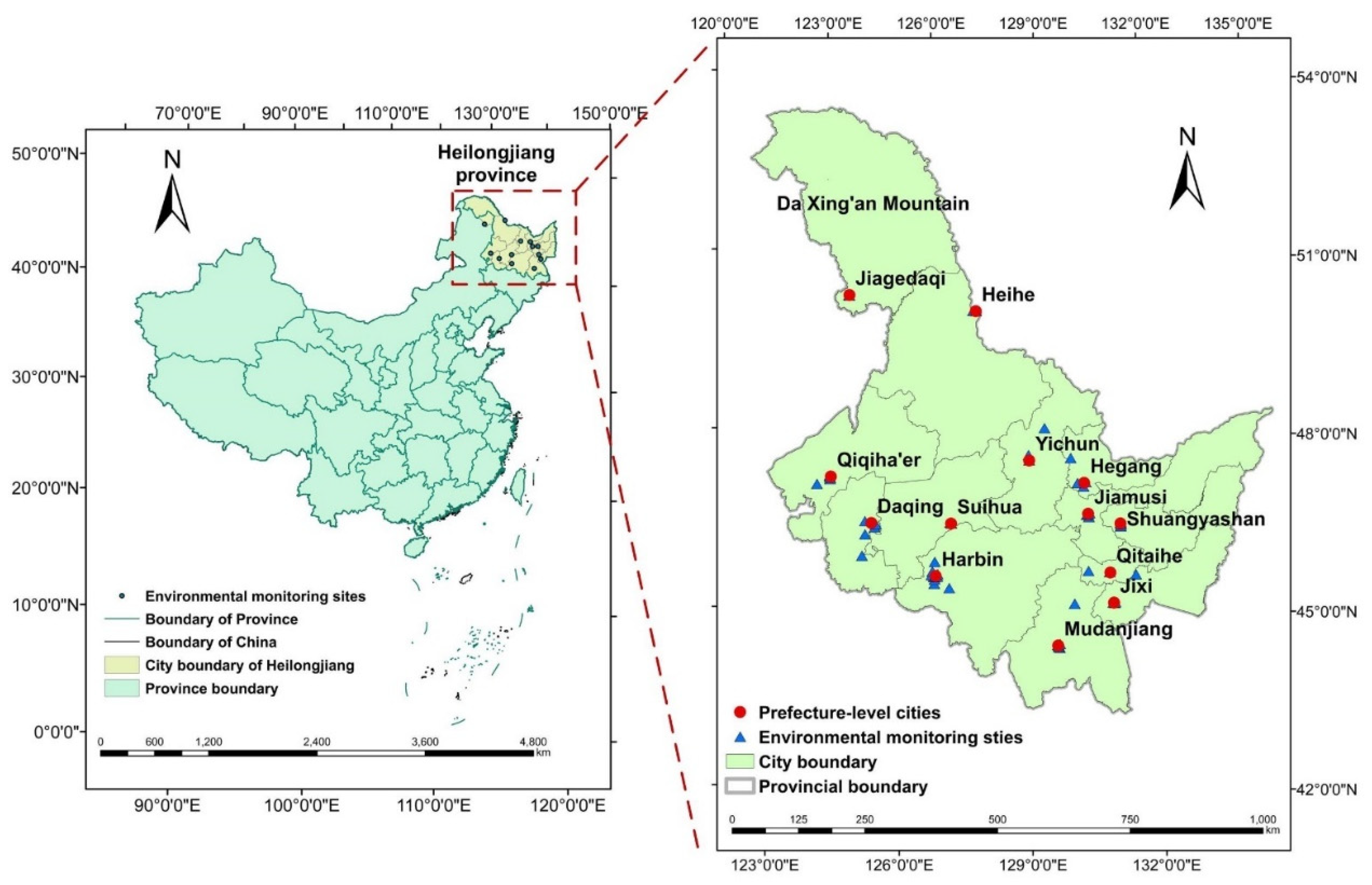
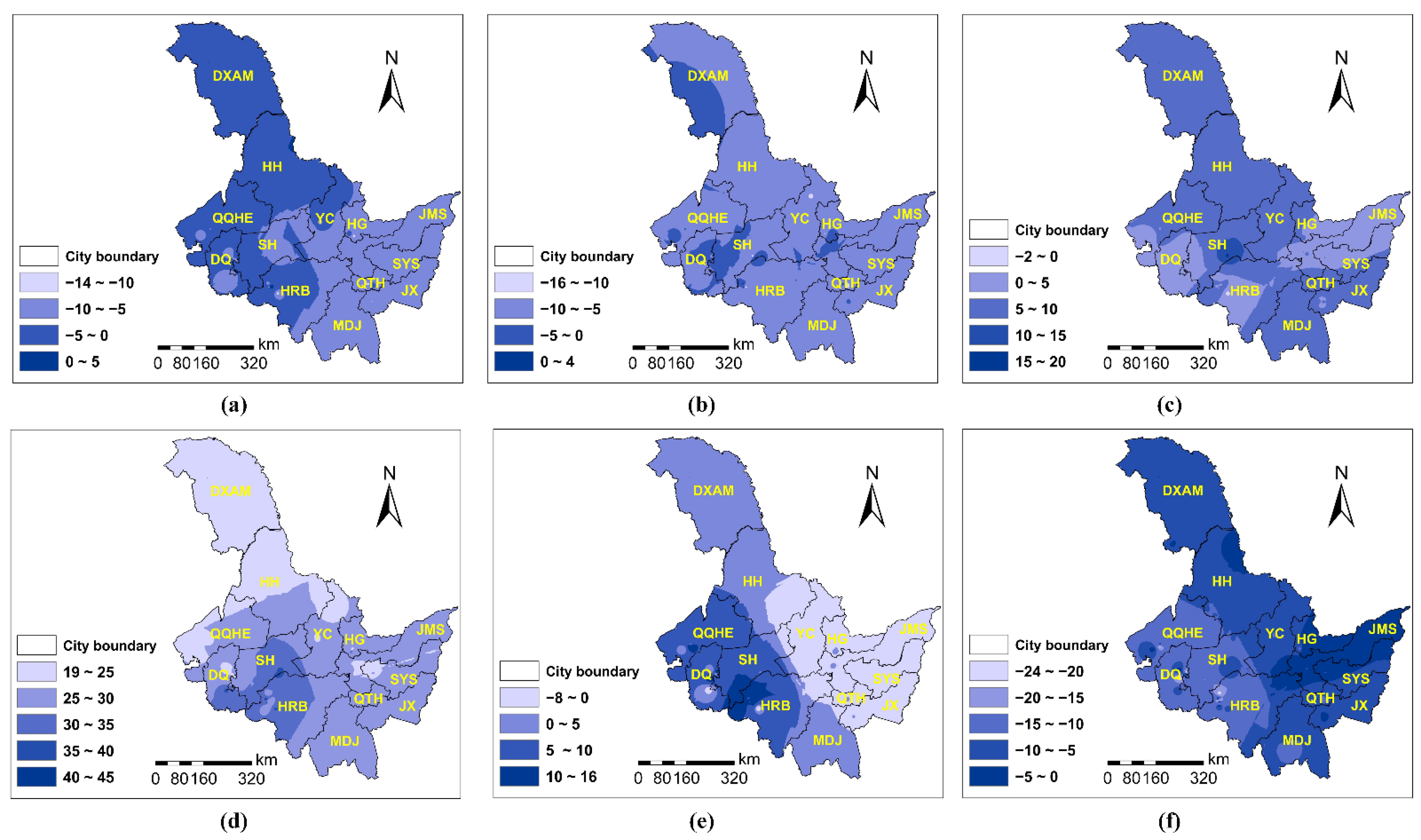
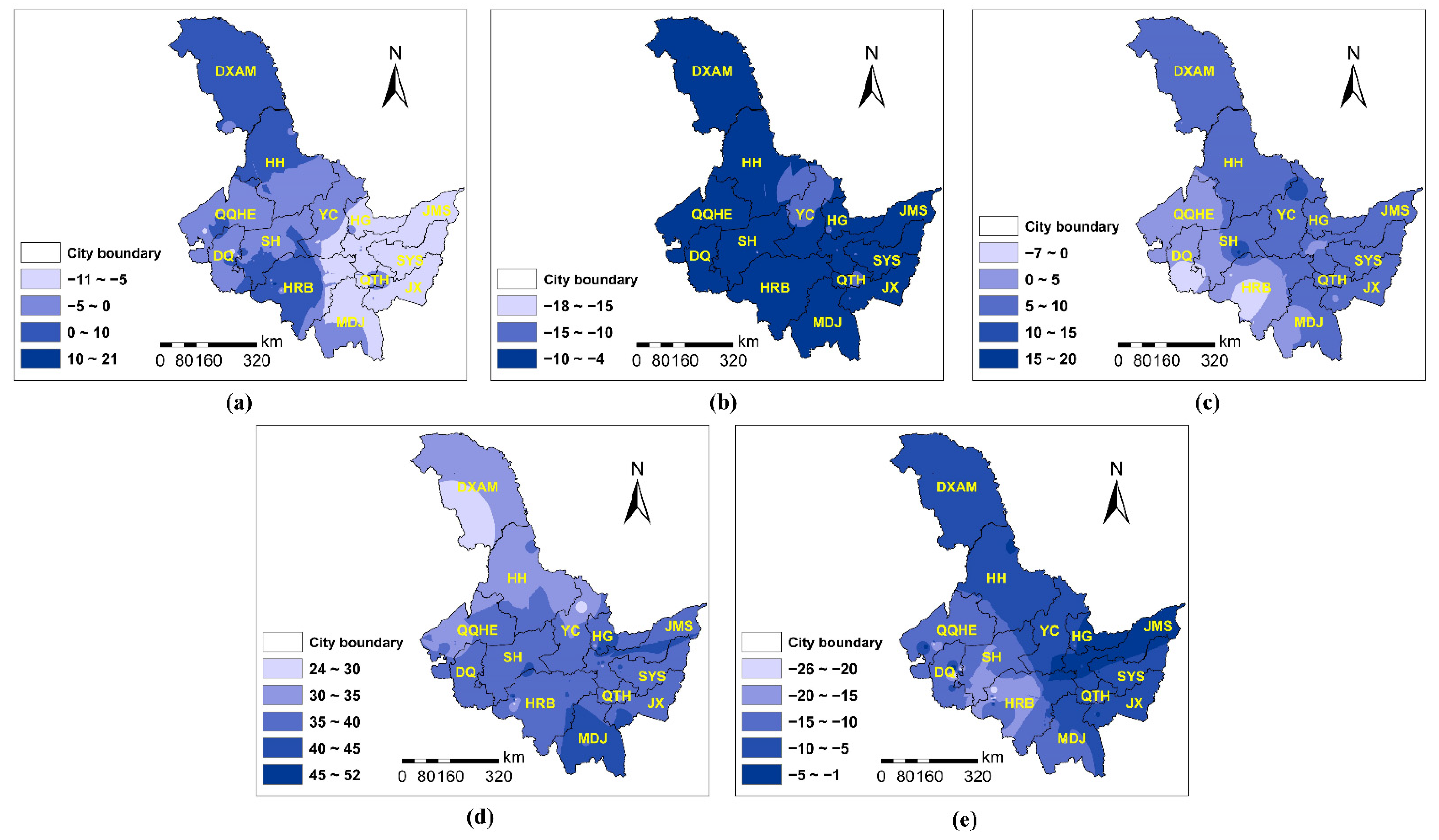
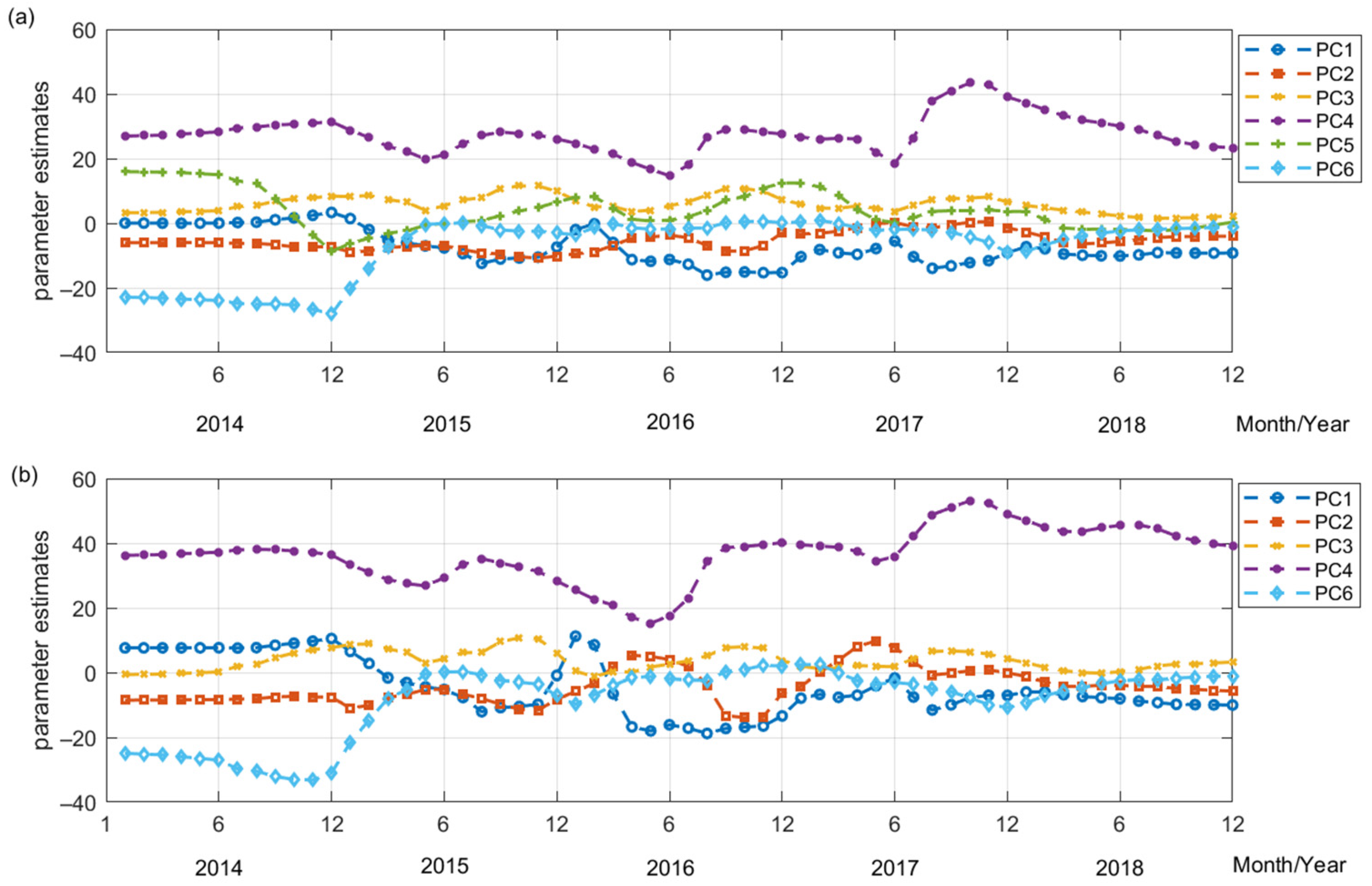
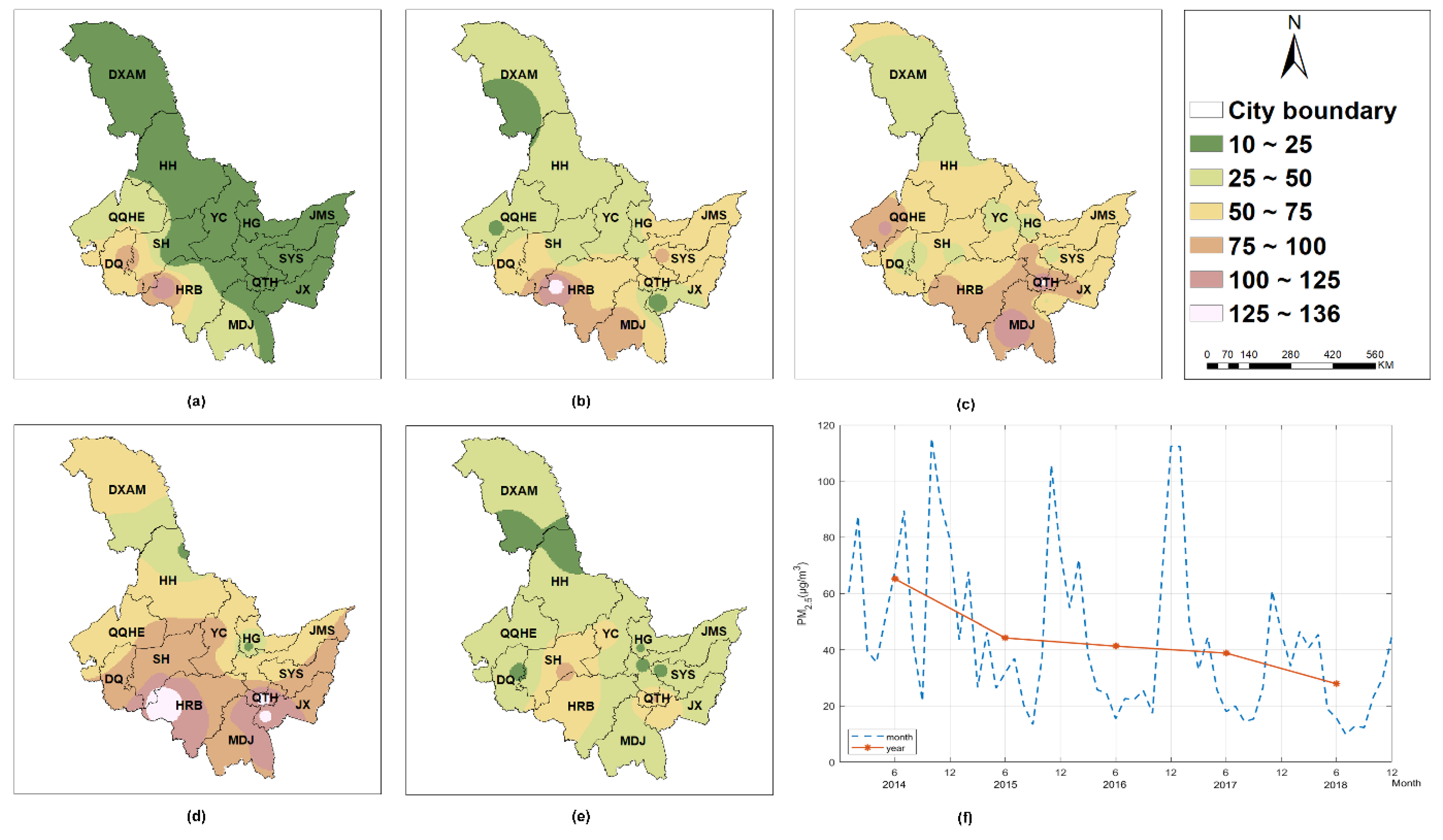
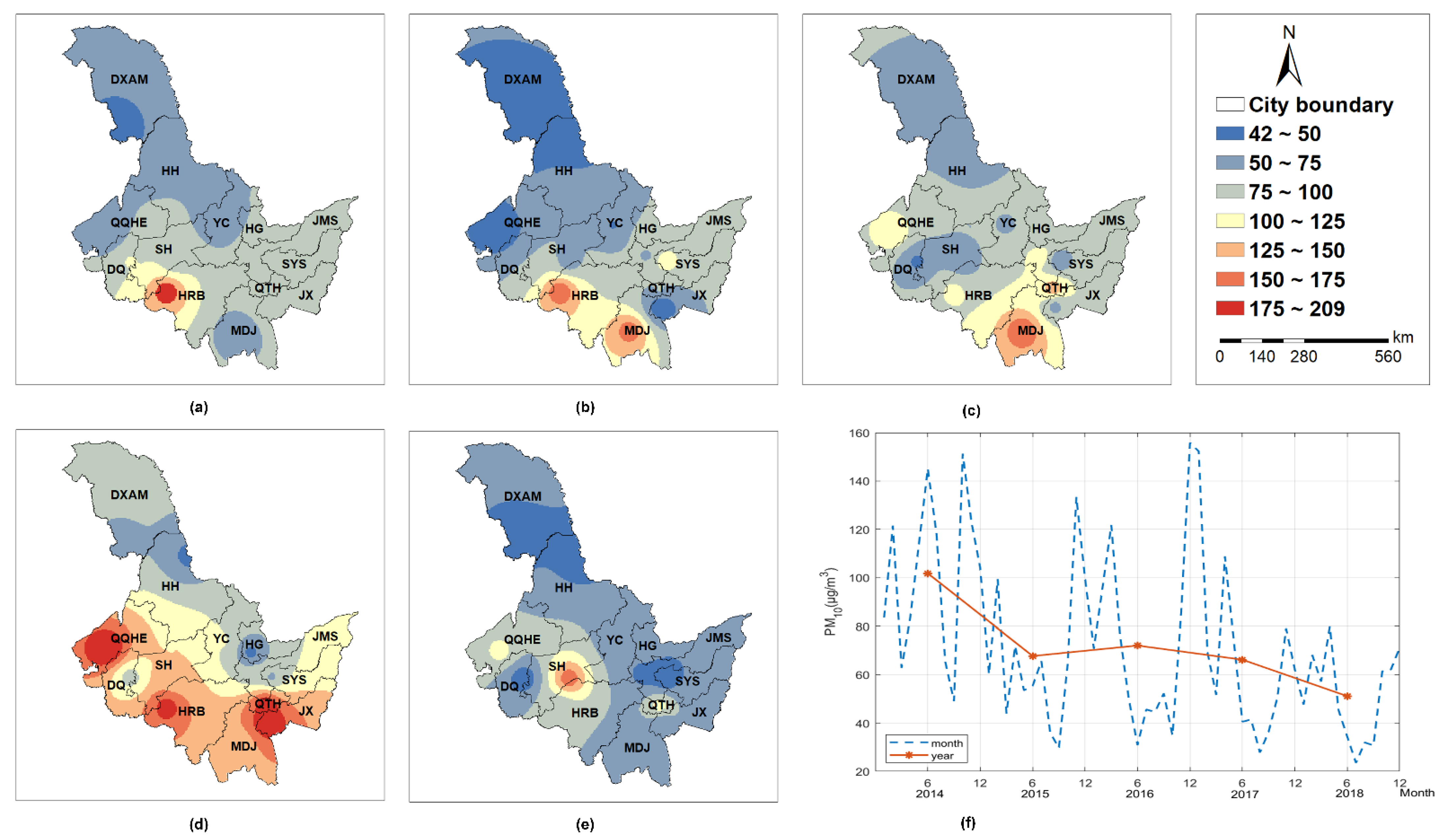
| Category | Variables | Min | Mean | Max | SD | Kurtosis | Skewness |
|---|---|---|---|---|---|---|---|
| Dependent variable | PM2.5 (μg/m3) | 4.00 | 41.08 | 262.00 | 37.17 | 6.59 | 2.35 |
| PM10 (μg/m3) | 10.00 | 66.74 | 341.00 | 46.82 | 3.95 | 1.85 | |
| Air pollutants | SO2 (μg/m3) | 2.00 | 20.66 | 191.00 | 21.34 | 13.80 | 3.03 |
| NO2 (μg/m3) | 2.00 | 28.37 | 101.00 | 16.15 | 1.94 | 1.31 | |
| CO (mg/m3) | 0.00 | 0.78 | 5.00 | 0.45 | 9.46 | 2.24 | |
| O3 (μg/m3) | 4.00 | 73.71 | 215.00 | 29.01 | 1.13 | 0.92 | |
| Meteorological factors | ARH | 0.24 | 0.62 | 0.94 | 0.13 | −0.13 | −0.37 |
| HCP (mm) | 0.00 | 0.50 | 23.64 | 1.76 | 41.32 | 5.78 | |
| SH(h) | 0.00 | 7.81 | 13.93 | 2.99 | −0.16 | −0.40 | |
| MaxP (hPa) | 951.36 | 996.44 | 1029.09 | 11.83 | −0.04 | −0.28 | |
| AP (hPa) | 947.56 | 993.94 | 1026.41 | 11.98 | 0.00 | −0.28 | |
| MinP (hPa) | 943.96 | 991.08 | 1021.70 | 12.13 | 0.02 | −0.31 | |
| MaxT (°C) | −26.57 | 7.47 | 36.06 | 15.81 | −1.38 | 0.00 | |
| AT (°C) | −36.47 | 1.13 | 28.70 | 15.57 | −1.33 | −0.02 | |
| MinT (°C) | −43.67 | −4.86 | 23.72 | 15.31 | −1.25 | −0.01 | |
| MaxWS (m/s) | 1.77 | 5.58 | 13.03 | 1.73 | 0.52 | 0.60 | |
| AWS (m/s) | 0.56 | 2.64 | 7.23 | 1.03 | 1.01 | 0.85 | |
| EWS (m/s) | 2.59 | 8.97 | 20.60 | 2.88 | 0.12 | 0.49 | |
| MaxST (°C) | −16.33 | 17.34 | 63.06 | 21.19 | −1.39 | 0.24 | |
| AST (°C) | −18.09 | 6.01 | 36.37 | 14.39 | −1.25 | 0.35 | |
| MinST (°C) | −23.40 | −1.22 | 23.36 | 10.43 | −0.92 | 0.42 | |
| Vegetation coverage | NDVI | −0.31 | −0.07 | 0.78 | 0.12 | 9.08 | 2.73 |
| PCs | PC1 | PC2 | PC3 | PC4 | PC5 | PC6 |
|---|---|---|---|---|---|---|
| SO2 (μg/m3) | −0.36 | −0.10 | 0.09 | 0.77 | 0.03 | 0.04 |
| NO2 (μg/m3) | −0.07 | −0.20 | 0.24 | 0.85 | −0.02 | −0.15 |
| CO (mg/m3) | −0.23 | −0.19 | 0.15 | 0.72 | 0.09 | −0.07 |
| O3 (μg/m3) | 0.56 | 0.10 | −0.14 | −0.11 | −0.46 | −0.27 |
| ARH | 0.03 | −0.46 | 0.02 | 0.14 | 0.74 | 0.08 |
| HCP (mm) | 0.25 | 0.05 | −0.13 | −0.12 | 0.69 | −0.08 |
| SH (h) | 0.49 | −0.06 | 0.00 | −0.18 | −0.69 | 0.09 |
| MaxP (hPa) | −0.27 | −0.02 | 0.94 | 0.18 | −0.04 | −0.06 |
| AP (hPa) | −0.26 | −0.08 | 0.94 | 0.17 | −0.04 | −0.05 |
| MinP (hPa) | −0.25 | −0.13 | 0.94 | 0.16 | −0.03 | −0.05 |
| MaxT (°C) | 0.95 | 0.05 | −0.21 | −0.14 | −0.06 | 0.07 |
| AT (°C) | 0.95 | 0.07 | −0.18 | −0.17 | 0.00 | 0.07 |
| MinT (°C) | 0.94 | 0.10 | −0.16 | −0.18 | 0.09 | 0.07 |
| MaxWS (m/s) | 0.02 | 0.97 | −0.11 | −0.12 | −0.04 | −0.01 |
| AWS (m/s) | 0.00 | 0.94 | 0.02 | −0.15 | −0.06 | 0.00 |
| EWS (m/s) | 0.12 | 0.95 | −0.13 | −0.16 | −0.06 | 0.01 |
| MaxST (°C) | 0.94 | 0.01 | −0.19 | −0.17 | −0.12 | 0.06 |
| AST (°C) | 0.96 | 0.00 | −0.19 | −0.14 | −0.02 | 0.07 |
| MinST (°C) | 0.92 | −0.02 | −0.18 | −0.12 | 0.18 | 0.08 |
| NDVI | 0.20 | −0.02 | −0.12 | −0.14 | −0.04 | 0.92 |
| Meaning of PCs (Cumulative Proportion) | Temperature (40%) | Wind speed (57%) | Pressure (67%) | Atmospheric pollutants (75%) | Humidity (82%) | Vegetation cover (87%) |
| PM2.5 | Estimate | t-Test | p-Value | PM10 | Estimate | t-Test | p-Value |
|---|---|---|---|---|---|---|---|
| Intercept | 41.08 | 136.27 | <2 × 10−16 | Intercept | 66.74 | 162.13 | <2 × 10−16 |
| PC1 | −7.39 | −24.50 | <2 × 10−16 | PC1 | −4.60 | −11.18 | <2 × 10−16 |
| PC2 | −5.18 | −17.17 | <2 × 10−16 | PC2 | −1.83 | −4.45 | 8.81× 10−6 |
| PC3 | 6.85 | 22.72 | <2 × 10−16 | PC3 | 4.72 | 11.47 | <2 × 10−16 |
| PC4 | 26.41 | 87.60 | <2 × 10−16 | PC4 | 33.43 | 81.20 | <2 × 10−16 |
| PC5 | 2.68 | 8.88 | <2 × 10−16 | PC6 | −4.67 | −11.33 | <2 × 10−16 |
| PC6 | −3.03 | −10.05 | <2 × 10−16 | ||||
| 0.61 | 0.54 | ||||||
| AICc | 54,275.10 | AICc | 57,976.60 |
| Models | Variables | Min | Mean | Max | SD | Kurtosis | Skewness | Model Fitting Information |
|---|---|---|---|---|---|---|---|---|
| PCA-GWR (Num of Neighbors = 1041) | intercept | 7.43 | 35.76 | 48.95 | 15.09 | −0.64 | −1.04 | : 0.68 AICc: 53,295.1 |
| PC1 | −13.61 | −5.75 | −0.18 | 4.29 | −1.37 | −0.25 | ||
| PC2 | −6.46 | −3.88 | −0.98 | 1.81 | −1.42 | 0.14 | ||
| PC3 | 2.05 | 12.01 | 26.14 | 8.40 | −1.02 | 0.70 | ||
| PC4 | 15.17 | 30.05 | 37.55 | 5.74 | 0.68 | −0.95 | ||
| PC5 | −2.74 | 3.63 | 8.86 | 2.88 | −0.83 | 0.11 | ||
| PC6 | −21.18 | −7.64 | −1.48 | 6.06 | −1.13 | −0.71 | ||
| PCA-TWR (Num of Neighbors = 595) | intercept | 5.18 | 39.68 | 95.87 | 13.87 | 4.50 | 0.87 | : 0.75 AICc: 51,804.3 |
| PC1 | −25.34 | −3.72 | 53.83 | 12.88 | 6.66 | 1.98 | ||
| PC2 | −14.13 | −4.17 | 8.21 | 4.40 | −0.01 | 0.09 | ||
| PC3 | −12.00 | 5.08 | 12.97 | 4.60 | 2.39 | −0.98 | ||
| PC4 | 1.20 | 22.77 | 59.16 | 11.46 | 1.07 | 0.67 | ||
| PC5 | −9.79 | 5.35 | 24.28 | 7.48 | −0.46 | 0.67 | ||
| PC6 | −32.19 | −4.41 | 6.96 | 7.63 | 3.01 | −1.83 | ||
| PCA-GTWR (Num of Neighbors = 595) | intercept | 23.64 | 41.86 | 59.43 | 6.47 | −0.56 | −0.04 | : 0.76 AICc: 51,607.2 |
| PC1 | −27.94 | −8.35 | 22.70 | 5.56 | 0.49 | 0.37 | ||
| PC2 | −19.60 | −4.64 | 10.77 | 4.41 | 1.71 | 0.13 | ||
| PC3 | −6.68 | 5.90 | 26.56 | 4.83 | 2.50 | 0.85 | ||
| PC4 | 8.64 | 28.79 | 51.43 | 8.41 | −0.24 | 0.43 | ||
| PC5 | −13.17 | 3.37 | 22.37 | 5.90 | 1.15 | 0.88 | ||
| PC6 | −35.30 | −5.04 | 8.47 | 7.56 | 2.89 | −1.87 |
| Models | Variables | Min | Mean | Max | SD | Kurtosis | Skewness | Model Fitting Information |
|---|---|---|---|---|---|---|---|---|
| PCA-GWR (Num of Neighbors = 937) | intercept | 27.39 | 62.51 | 85.65 | 19.74 | −0.88 | 0.26 | : 0.63 AICc: 56,894.4 |
| PC1 | −12.54 | −2.01 | 9.20 | 6.36 | −0.89 | 0.08 | ||
| PC2 | −8.22 | −0.14 | 6.69 | 4.75 | −1.34 | 0.06 | ||
| PC3 | −1.77 | 11.45 | 25.94 | 8.29 | −0.65 | 0.11 | ||
| PC4 | 23.41 | 40.44 | 45.95 | 6.13 | 2.02 | 0.08 | ||
| PC6 | −20.11 | −8.67 | −2.41 | 4.64 | −0.83 | 0.06 | ||
| PCA-TWR (Num of Neighbors = 602) | intercept | 0.56 | 66.42 | 155.0 | 22.90 | 6.32 | 1.38 | : 0.71 AICc: 55,447.7 |
| PC1 | −24.92 | 1.12 | 84.12 | 20.42 | 6.80 | 2.36 | ||
| PC2 | −15.84 | −3.22 | 21.88 | 8.36 | 0.46 | 0.87 | ||
| PC3 | −21.35 | 3.70 | 14.46 | 6.36 | 4.30 | −1.70 | ||
| PC4 | 1.36 | 30.63 | 69.10 | 12.93 | 0.70 | 0.38 | ||
| PC6 | −32.82 | −5.32 | 11.66 | 8.26 | 2.70 | −1.54 | ||
| PCA-GTWR (Num of Neighbors = 595) | intercept | 39.12 | 69.63 | 114.6 | 11.16 | −0.63 | 0.18 | : 0.73 AICc: 55,114.7 |
| PC1 | −31.98 | −5.83 | 45.62 | 8.41 | 2.03 | 0.79 | ||
| PC2 | −21.94 | −2.82 | 22.36 | 6.87 | 0.83 | 0.52 | ||
| PC3 | −13.21 | 3.65 | 27.61 | 6.36 | 1.16 | 0.18 | ||
| PC4 | 9.26 | 38.04 | 60.40 | 10.78 | −0.43 | −0.10 | ||
| PC6 | −36.97 | −6.44 | 12.97 | 8.81 | 2.37 | −1.60 |
| Model | PM2.5 | PM10 | ||||||
|---|---|---|---|---|---|---|---|---|
| AICc | RMSE (μg/m3) | MAE (μg/m3) | AICc | RMSE (μg/m3) | MAE (μg/m3) | |||
| PCA-OLS | 54,275.10 | 0.61 | 23.23 | 0.30 | 57,976.60 | 0.54 | 31.72 | 0.41 |
| PCA-GWR | 53,295.10 | 0.68 | 21.16 | 0.27 | 56,892.60 | 0.63 | 28.62 | 0.37 |
| PCA-TWR | 51,804.30 | 0.75 | 18.59 | 0.24 | 55,836.90 | 0.69 | 26.16 | 0.34 |
| PCA-GTWR | 51,607.20 | 0.76 | 18.20 | 0.24 | 55,365.10 | 0.71 | 25.04 | 0.33 |
Publisher’s Note: MDPI stays neutral with regard to jurisdictional claims in published maps and institutional affiliations. |
© 2022 by the authors. Licensee MDPI, Basel, Switzerland. This article is an open access article distributed under the terms and conditions of the Creative Commons Attribution (CC BY) license (https://creativecommons.org/licenses/by/4.0/).
Share and Cite
Fu, L.; Wang, Q.; Li, J.; Jin, H.; Zhen, Z.; Wei, Q. Spatiotemporal Heterogeneity and the Key Influencing Factors of PM2.5 and PM10 in Heilongjiang, China from 2014 to 2018. Int. J. Environ. Res. Public Health 2022, 19, 11627. https://doi.org/10.3390/ijerph191811627
Fu L, Wang Q, Li J, Jin H, Zhen Z, Wei Q. Spatiotemporal Heterogeneity and the Key Influencing Factors of PM2.5 and PM10 in Heilongjiang, China from 2014 to 2018. International Journal of Environmental Research and Public Health. 2022; 19(18):11627. https://doi.org/10.3390/ijerph191811627
Chicago/Turabian StyleFu, Longhui, Qibang Wang, Jianhui Li, Huiran Jin, Zhen Zhen, and Qingbin Wei. 2022. "Spatiotemporal Heterogeneity and the Key Influencing Factors of PM2.5 and PM10 in Heilongjiang, China from 2014 to 2018" International Journal of Environmental Research and Public Health 19, no. 18: 11627. https://doi.org/10.3390/ijerph191811627
APA StyleFu, L., Wang, Q., Li, J., Jin, H., Zhen, Z., & Wei, Q. (2022). Spatiotemporal Heterogeneity and the Key Influencing Factors of PM2.5 and PM10 in Heilongjiang, China from 2014 to 2018. International Journal of Environmental Research and Public Health, 19(18), 11627. https://doi.org/10.3390/ijerph191811627






